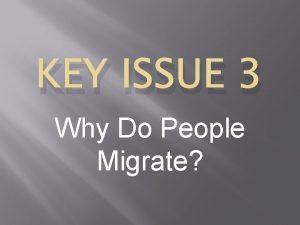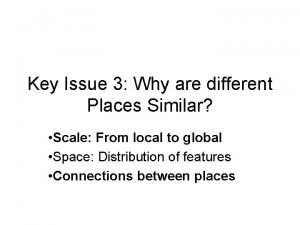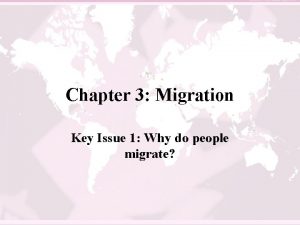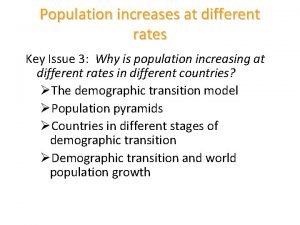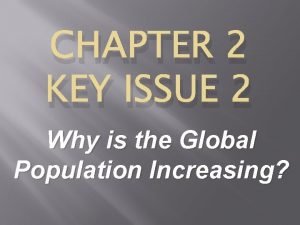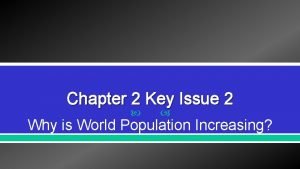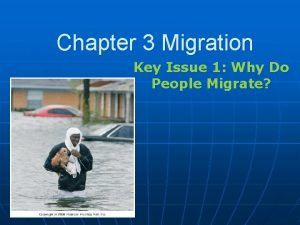CHAPTER 2 KEY ISSUE 4 Why Do Some












































- Slides: 44

CHAPTER 2 KEY ISSUE 4 Why Do Some Regions Face Health Threats?

Last class, we examined the DEMOGRAPHIC TRANSITION model, which describes the variance in natural growth rates between countries.

Today, we will look at another model that works in PARALLEL with the DTM.

This second model focus on DEATH RATES, and what drives them as a country matures.

EPIDEMIOLOGICAL TRANSITION MODEL Identifies distinct health threats in each stage of the Demographic Transition model.

Stage 1 – Pestilence and Famine (High CDR, High CBR) �During stage 1 most deaths occur due to PANDEMICS (infectious/parasitic diseases) or from ENVIRONMENTAL FACTORS (floods, earthquakes, drought…)

A PANDEMIC is a disease or other ailment which spreads across a wide area of the Earth’s surface, deeply impacting multiple countries or even continents.

A EPIDEMIC is an ailment which deeply impacts a community or region (smaller scale than pandemic)

1347 -50 The BLACK PLAGUE was the deadliest of the Stage 1 pandemics; more than HALF of Europe died- IN THREE YEARS.

It was spread from Central Asia to Europe on fleas carried by rats on ships, so port cities were the first to fall victim.

Men known as PLAGUE DOCTORS traveled to help the sick. Because plague was believed to be spread by ‘foul-smelling air, ’ they wore a mask filled with scented herbs. They also carried a stick to keep any infected person at distance.


Stage 2 – Receding Pandemics (High CBR, falling CDR) �Improved sanitation, nutrition, and medicine lead to a reduction in epidemics; overall

EPIDEMIOLOGY makes its rise in Stage 2; doctors work to understand the actual causes and cures for diseases.

DEVELOPMENT has much to do with movement into Stage 2. As countries mature, they build life-saving INFRASTRUCTURE, like hospitals and sewers.

John Snow’s famous 1854 Cholera Study is an example of Stage 2 epidemiology.

Stage 3 – Degenerative Diseases (Dropping CBR, Low CDR) � During Stage 3, people are living longer than ever before, and chronic diseases associated with age become society’s greatest health challenge.

With people living longer lives, new health conditions become prevalent in Stage 3. Chief among these are CANCER and CARDIOVASCULAR DISEASE.

Infant mortality drops dramatically in Stage 2, so by Stage 3 women are starting to have less babies (more will survive until adulthood).

Stage 4 – Delayed Degenerative Diseases (Low CBR, Low CDR) �Deaths caused by cardiovascular diseases, cancer, and other progressive diseases delayed by modern medical technology and treatments.

People are surviving longer even with deadly conditions, leading to a GREYING population.

Today, Italy’s population is rapidly aging. What will happen when its ‘bulge’ – currently 40 -50 – ages into their 70, 80 s, and 90 s?

GLOBAL ISSUE: GREYING POPULATIONS

Because of the epidemiologic transition, health patterns are very different in the developed and

Stage 1 -2 problems. MALARIA RATES

Stage 1 -2 Problems. STARVATION & MALNUTRITION

Stage 3 -4 problems. CANCER RATES

Stage 3 -4 problems. OBESITY RATES

STAGE 5 – Low CBR, rising CDR � During stage 5 of the Demographic Transition, death rates begin to rise, sometimes even above the CBR (leading to negative NIR). � The Epidemiologic Transition model offers three possible explanations for this.

1. ) DISEASE EVOLUTION � Infectious disease microbes evolve and establish RESISTANCE to drugs and other treatments. � Antibiotics and genetic engineering contributes to the emergence of stronger strains of viruses and bacteria.

Spread of drug-resistant H 1 N 1 Flu (2009)

2. ) POVERTY � � Though development in Stage 5 countries is high, it is still uneven. Even the most modern societies still harbor pockets of poverty. Infectious diseases are more prevalent in poor areas due to presence of unsanitary conditions, and inability to afford drugs needed for treatment.

3. ) INCREASED CONNECTIONS Advancements in modes of transportation, especially air travel, makes it easier for an individual infected in one place to rapidly transmit disease elsewhere. �

Imagine the impact of ONE INFECTED PERSON in Atlanta…

AIDS is most prevalent in cities with massive international airports (numbers are millions of int’l arrivals)

Health Care �Health services vary widely around the world, primarily, because countries possess different resources to care for people who are sick.

Hospital in Sierra Leone, West Africa

Recovery room in Hartford Hospital

HEALTH CARE Health services also vary because governments spend different amounts on healthcare. Gov’t Expenditures on Healthcare: � More than 15 percent of total government expenditures in Europe and North America. � Less than 5 percent in sub. Saharan Africa and South Asia.


HEALTH CARE in MOST DEVELOPED COUNTRIES � Public service available at little or no cost. � Government pays more than 70 percent of individuals’ health-care costs in most European countries.

HEALTH CARE in DEVELOPING COUNTRIES �Private individuals must pay more than half of the cost of health care, in many places more than 70%. �All on wages significantly lower than developed world!


HEALTH CARE in the UNITED STATES individuals are required to pay about 55 percent of health care costs- more closely � Private resembling a developing country. � $$$$$$$$$$$
 Chapter 2 population and health key issue 3
Chapter 2 population and health key issue 3 Key issue 4 why are some actions not sustainable
Key issue 4 why are some actions not sustainable Key issue 4 why are some actions not sustainable
Key issue 4 why are some actions not sustainable Pictures
Pictures Why are situation and site factors important
Why are situation and site factors important Key issue 1: why do services cluster downtown?
Key issue 1: why do services cluster downtown? Why are downtowns distinctive
Why are downtowns distinctive Key issue 4 why do countries face obstacles to development
Key issue 4 why do countries face obstacles to development Key issue 3 why do individual languages vary among places
Key issue 3 why do individual languages vary among places Key issue 4: why do people preserve local languages?
Key issue 4: why do people preserve local languages? Key issue 3 why do people migrate
Key issue 3 why do people migrate Why are different places similar geography
Why are different places similar geography How and why are places similar
How and why are places similar Chapter 3 key issue 1
Chapter 3 key issue 1 Chapter 3 key issue 4
Chapter 3 key issue 4 Key issue 4 why do migrants face obstacles
Key issue 4 why do migrants face obstacles Key issue 3 why does population growth vary among regions
Key issue 3 why does population growth vary among regions Chapter 13 key issue 3
Chapter 13 key issue 3 Chapter 12 key issue 1
Chapter 12 key issue 1 Chapter 12 key issue 1
Chapter 12 key issue 1 Chapter 11 key issue 4
Chapter 11 key issue 4 Language
Language Chapter 5 key issue 4
Chapter 5 key issue 4 Chapter 4 key issue 3
Chapter 4 key issue 3 Chapter 13 key issue 4
Chapter 13 key issue 4 Key issue 2 where are consumer services distributed
Key issue 2 where are consumer services distributed Received pronunciation definition ap human geography
Received pronunciation definition ap human geography Chapter 6 key issue 4
Chapter 6 key issue 4 Chapter 5 key issue 2
Chapter 5 key issue 2 Chapter 4 key issue 2
Chapter 4 key issue 2 Chapter 2 key issue 2
Chapter 2 key issue 2 Chapter 2 key issue 1
Chapter 2 key issue 1 Bulk reducing industry examples
Bulk reducing industry examples Dont ask why why why
Dont ask why why why Sometimes you win some sometimes you lose some
Sometimes you win some sometimes you lose some Sometimes you win some
Sometimes you win some Ice cream is countable
Ice cream is countable Contact force
Contact force Some say the world will end in fire some say in ice
Some say the world will end in fire some say in ice Some say the world will end in fire some say in ice
Some say the world will end in fire some say in ice Some trust in horses
Some trust in horses Which key resources are we acquiring from partners
Which key resources are we acquiring from partners Key partners key activities key resources
Key partners key activities key resources Protestant reformation worksheet answer key
Protestant reformation worksheet answer key What is fair trade coffee why is it an ethical issue
What is fair trade coffee why is it an ethical issue










